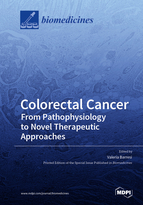Colorectal Cancer: From Pathophysiology to Novel Therapeutic Approaches
A special issue of Biomedicines (ISSN 2227-9059). This special issue belongs to the section "Molecular and Translational Medicine".
Deadline for manuscript submissions: closed (31 December 2020) | Viewed by 50234
Special Issue Editor
Interests: brain tumors; meningioma; glioma; colorectal cancer; prognostic markers; tumor budding; poorly differentiated clusters
Special Issues, Collections and Topics in MDPI journals
Special Issue Information
Dear Colleagues,
Colorectal cancer (CRC) is one of the most common malignancies worldwide. Therapeutic approach varies according to tumor location (colonic or rectal) and pTNM stage, the latter representing a main prognostic factor. In view of the overall good prognosis of nonmetastatic CRC, adjuvant treatments are not recommended in pTNM stage I, and their use is controversial in pTNM stage II. However, 10%–20% of patients undergo disease progression and would have benefitted from adjuvant therapies.
The identification of patients with nonmetastatic CRC at a high risk of progression is a future research challenge. In this regard, studies using liquid biopsy or searching fpr histological and molecular factors associated with metastatization could provide relevant information.
In recent years, immune check point inhibitors have shown promising results in the treatment of a subset of metastatic CRC with high microsatellite instability (MSI). MSI CRC show dense immune cell infiltration, which is induced by numerous neoantigens created by the high mutational burden (TMB) in relation to the deficient mismatch repair system. However, whether MSI is an optimal marker to predict response to immune check point inhibitors is still to be clarified. In addition, it is unclear whether microsatellite stable CRCs with high TMB may respond to these therapies.
The aim of this Special Issue is to give an insight into the process of metastatization in CRC and into molecular and histopathological factors which may be predictive of novel therapies for this tumor.
Prof. Valeria Barresi
Guest Editor
Manuscript Submission Information
Manuscripts should be submitted online at www.mdpi.com by registering and logging in to this website. Once you are registered, click here to go to the submission form. Manuscripts can be submitted until the deadline. All submissions that pass pre-check are peer-reviewed. Accepted papers will be published continuously in the journal (as soon as accepted) and will be listed together on the special issue website. Research articles, review articles as well as short communications are invited. For planned papers, a title and short abstract (about 100 words) can be sent to the Editorial Office for announcement on this website.
Submitted manuscripts should not have been published previously, nor be under consideration for publication elsewhere (except conference proceedings papers). All manuscripts are thoroughly refereed through a single-blind peer-review process. A guide for authors and other relevant information for submission of manuscripts is available on the Instructions for Authors page. Biomedicines is an international peer-reviewed open access monthly journal published by MDPI.
Please visit the Instructions for Authors page before submitting a manuscript. The Article Processing Charge (APC) for publication in this open access journal is 2600 CHF (Swiss Francs). Submitted papers should be well formatted and use good English. Authors may use MDPI's English editing service prior to publication or during author revisions.
Keywords
- liquid biopsy
- epithelial–mesenchymal transition
- tumor budding
- poorly differentiated clusters
- tumor mutational burden
- microsatellite instability
- immune check point inhibitors
- tumor-infiltrating lymphocytes







